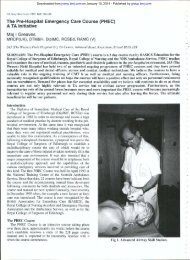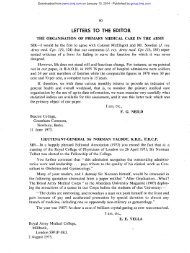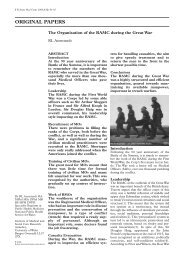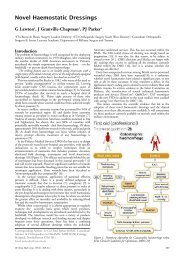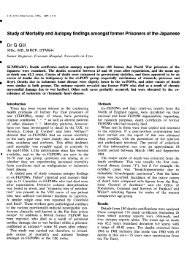A Henderson. Encephalitis in Nepal: The Visitation of the Goddess ...
A Henderson. Encephalitis in Nepal: The Visitation of the Goddess ...
A Henderson. Encephalitis in Nepal: The Visitation of the Goddess ...
You also want an ePaper? Increase the reach of your titles
YUMPU automatically turns print PDFs into web optimized ePapers that Google loves.
Downloaded from jramc.bmj.com on January 10, 2014 - Published by group.bmj.com<br />
J R Army Med Corps, 1983; 129: 156-162<br />
<strong>Encephalitis</strong> <strong>in</strong> <strong>Nepal</strong>: <strong>The</strong> <strong>Visitation</strong> <strong>of</strong> <strong>The</strong> <strong>Goddess</strong> <strong>of</strong> <strong>The</strong> Forest<br />
Maj A <strong>Henderson</strong><br />
BMedSci, MRCP, RAMC<br />
British Military Hospital, Dharan<br />
SUMMARY: Exam<strong>in</strong>ation <strong>of</strong> hospital records from BMH Dhar~lll and <strong>the</strong> large <strong>Nepal</strong>ese hospital at Biratnagar<br />
has revealed a worry<strong>in</strong>g trend <strong>in</strong> <strong>the</strong> <strong>in</strong>cidence <strong>of</strong> acute encephalitis <strong>in</strong> <strong>the</strong> area <strong>of</strong> <strong>the</strong> British Military<br />
Cantonment at Dharan. <strong>The</strong> weight <strong>of</strong> available evidence strongly favours Japanese <strong>Encephalitis</strong> Virus<br />
(JEV) as <strong>the</strong> aetiological agent. Serological studies from healthy <strong>Nepal</strong>ese from <strong>the</strong> Dharan area and animals<br />
from <strong>the</strong> Cantonment farm <strong>in</strong>dicate that <strong>in</strong>tense transm ission <strong>of</strong> lEV occurs with<strong>in</strong> <strong>the</strong> Cantonment area.<br />
Japanese <strong>Encephalitis</strong> (lE) must now be regarded as a serious threat to British Military personnel and<br />
dependants liv<strong>in</strong>g <strong>in</strong> or visit<strong>in</strong>g <strong>Nepal</strong>. Protective measures, particularly active immunisation are discussed.<br />
Introduction<br />
<strong>The</strong> British Military Cantonment at Dharan lies<br />
on <strong>the</strong> nOl1<strong>the</strong>rn fr<strong>in</strong>ge <strong>of</strong> <strong>the</strong> Terai region <strong>of</strong> eastern<br />
<strong>Nepal</strong> <strong>in</strong> <strong>the</strong> Koshi Zone. <strong>The</strong> Terai is a fiat fertile<br />
rice grow<strong>in</strong>g pla<strong>in</strong> border<strong>in</strong>g <strong>the</strong> nor<strong>the</strong>rn states <strong>of</strong><br />
India. <strong>The</strong> Cantonment supports a population <strong>of</strong><br />
British and Gurkha soldiers and <strong>the</strong>ir families and<br />
a large force <strong>of</strong> local <strong>Nepal</strong>ese who live or work<br />
with<strong>in</strong> its area.<br />
Although acute encephalitis, known to <strong>the</strong> locals<br />
as <strong>the</strong> "visitation <strong>of</strong> <strong>the</strong> goddess <strong>of</strong> <strong>the</strong> forest," has<br />
probably always been a feature <strong>of</strong> life on <strong>the</strong> Terai,<br />
it appeared to be uncommon <strong>in</strong> <strong>the</strong> Dharan area<br />
before 1970. S<strong>in</strong>ce <strong>the</strong>n each summer, cases have<br />
been admitted to <strong>the</strong> BMH and to <strong>the</strong> local <strong>Nepal</strong>ese<br />
hospitals <strong>in</strong> <strong>in</strong>creas<strong>in</strong>g numbers. This <strong>in</strong> conjunction<br />
with <strong>the</strong> appearance <strong>of</strong> severe epidemics <strong>of</strong> Japanese<br />
<strong>Encephalitis</strong> (JE) <strong>in</strong> neighbour<strong>in</strong>g parts <strong>of</strong> <strong>the</strong> Indian<br />
subcont<strong>in</strong>ent!, 2, 3 suggested a threat might exist to<br />
British Military personnel liv<strong>in</strong>g <strong>in</strong> or visit<strong>in</strong>g <strong>Nepal</strong>.<br />
This paper explores <strong>the</strong> extent <strong>of</strong> <strong>the</strong> encephalitis<br />
threat, presents evidence implicat<strong>in</strong>g <strong>the</strong> Japanese<br />
<strong>Encephalitis</strong> Virus (JEV) ;:IS <strong>the</strong> pr<strong>in</strong>cipal casual agent<br />
and suggests measures that might be taken to reduce<br />
<strong>the</strong> risk <strong>of</strong> JEV transmission to man and <strong>the</strong> consequences<br />
<strong>of</strong> this.<br />
Materials and Methods<br />
<strong>The</strong> study was carried out <strong>in</strong> 4 phases.<br />
PHASE I: <strong>The</strong> cl<strong>in</strong>ical records <strong>of</strong> all patients<br />
admitted to BMH Dharan with acute encephalitis<br />
were exam<strong>in</strong>ed. <strong>The</strong> case f<strong>in</strong>d<strong>in</strong>g was probably <strong>in</strong>complete<br />
due to <strong>the</strong> absence <strong>of</strong> a data retrieval<br />
system. Cl<strong>in</strong>ical and laboratory data were extracted<br />
'W<strong>in</strong>ches Fwm is a field station near St Albans<br />
<strong>of</strong> <strong>the</strong> London School <strong>of</strong> Hygiene & Tropical<br />
Medic<strong>in</strong>e.<br />
from <strong>the</strong> records and where available <strong>the</strong> results <strong>of</strong><br />
flavivirus serology wert; exam<strong>in</strong>ed. Serum was tested<br />
for evidence <strong>of</strong> flavivirus antibodies ei<strong>the</strong>r at <strong>the</strong><br />
Special Pathogens laboratory, Porton or <strong>the</strong> Virus<br />
Reference laboratory, Col<strong>in</strong>dale.<br />
PHASE n: Dharan lies on <strong>the</strong> nor<strong>the</strong>rn fr<strong>in</strong>ge<br />
<strong>of</strong> <strong>the</strong> Terai <strong>in</strong> <strong>the</strong> Koshi Zone. To determ<strong>in</strong>e <strong>the</strong><br />
extent <strong>of</strong> <strong>the</strong> encephalitis problem <strong>in</strong> <strong>the</strong> sou<strong>the</strong>rn<br />
Terai lhe <strong>in</strong>patient analysis data from Biratnagar<br />
hospital was exami:led. Biratnagar is <strong>the</strong> larGest town<br />
<strong>in</strong> <strong>the</strong> Koshi Zone and lies almost due south <strong>of</strong><br />
Dharan ne:lr <strong>the</strong> Indian border. It is ioportant<br />
from <strong>the</strong> military view-po<strong>in</strong>t <strong>in</strong> that all military<br />
personnel and families fly<strong>in</strong>g to and from Katmandu<br />
do so via Biratnagar airport.<br />
PHASE Ill: To detect evidence <strong>of</strong> Jauan.:::c<br />
<strong>Encephalitis</strong> Virus (JEV) transmission on <strong>the</strong> Dharan<br />
Military Cantonment blood was taken from known<br />
amplify<strong>in</strong>g hosts on <strong>the</strong> Cantonment re3etllemenl<br />
farm. Serum from 16 pigs <strong>of</strong> vary<strong>in</strong>g ages was<br />
tested by Haemagglut<strong>in</strong>ation Inhibition (HAT) for<br />
JEV antibody at <strong>the</strong> Arbovirus Unit, W<strong>in</strong>ches Farm'<br />
London and serum from adult buffaloes, chickens<br />
and ducks tested by HAT at <strong>the</strong> Armed Forces<br />
Rese'lrch Institute <strong>of</strong> Medical Sciences (AFRIMS)<br />
Dangkok. All <strong>the</strong> animals tested had spent <strong>the</strong>ir<br />
entire lives on <strong>the</strong> farm.<br />
PHASE IV -- To detect evidence <strong>of</strong> <strong>in</strong>apparent<br />
JEV transmission to local <strong>Nepal</strong>ese· serum from a<br />
sample <strong>of</strong> 20 <strong>Nepal</strong>ese men work<strong>in</strong>g on <strong>the</strong> Cantonment<br />
was tested by HAI at AFRIMS. Serum from<br />
20 UK soldiers and families was similarly tested to<br />
gauge <strong>the</strong>ir susceptibility to JEV.
Downloaded from jramc.bmj.com on January 10, 2014 - Published by group.bmj.com<br />
A <strong>Henderson</strong><br />
157<br />
Results<br />
PHASE T - Cl<strong>in</strong>ical data<br />
<strong>The</strong> notes <strong>of</strong> 43 patients were reviewed, <strong>of</strong> whom<br />
eight were seen personally <strong>in</strong> 1982.<br />
Age and Sex. <strong>The</strong> mean age <strong>of</strong> <strong>the</strong> group was<br />
15 years (range 5 months to 63 years). 27 (62%)<br />
were under 20 years <strong>of</strong> age. <strong>The</strong> sex <strong>in</strong>cidence was<br />
similar (20 males, 23 females).<br />
Place 0/ Domicile. Dharan -- 24, Terai - 14,<br />
Hms - 3, Military Cantonment - 2.<br />
Season. Although occasional cases occurred<br />
throughout <strong>the</strong> ye:!r <strong>the</strong> majority occurred <strong>in</strong> relation<br />
to <strong>the</strong> summer monsoon (Fig. 1). 74% <strong>of</strong> cases<br />
occurred between <strong>the</strong> months <strong>of</strong> August and October.<br />
15<br />
10<br />
5<br />
,Fig.<br />
J M A M J'<br />
MONTHS<br />
Monthly <strong>in</strong>cidence <strong>of</strong> encephalitis<br />
Yearly Incidence. <strong>The</strong> disease appears to have<br />
been uncommon before 1970. S<strong>in</strong>ce <strong>the</strong>n <strong>the</strong> annual<br />
<strong>in</strong>cidence has been <strong>in</strong>creas<strong>in</strong>g (Fig. 2).<br />
20 I<br />
rz:l 15<br />
~<br />
H 10<br />
~<br />
5<br />
o<br />
! I I i I<br />
1971-72 1973-74 1975-76 1977-78 1979-80 1981-82<br />
Fig. 2<br />
YEARS<br />
Annual <strong>in</strong>Cidence <strong>of</strong> encephalitis<br />
Mode <strong>of</strong> onset. <strong>The</strong> majority had a non-specific<br />
prodrome last<strong>in</strong>g a few days before <strong>the</strong> onset <strong>of</strong><br />
def<strong>in</strong>ite encephalitic features. In addition to malaise,<br />
anorexia and fever, 58 % had severe headache and<br />
32% vomit<strong>in</strong>g. In 19% <strong>the</strong> prodromal symptoms<br />
were not well recorded. Towards <strong>the</strong> end <strong>of</strong> this<br />
stage and <strong>of</strong>ten precipitat<strong>in</strong>g hospital admission<br />
came symptoms <strong>of</strong> severe cerebral dysfunction.<br />
Disturbance <strong>of</strong> consciousness occurred <strong>in</strong> 100%,<br />
aphonia <strong>in</strong> 42% and grand mal fits <strong>in</strong> 40%. In a<br />
m<strong>in</strong>ority <strong>the</strong> disease was explosive with high fever<br />
and a rapidly fatal acute bra<strong>in</strong> syndrome.<br />
One patient demonstrated wildly disturbed behaviour<br />
for 3 days before laps<strong>in</strong>g <strong>in</strong>to fatal coma.<br />
Physical F<strong>in</strong>d<strong>in</strong>gs<br />
(a) Fever. 76% were febrile on admission, <strong>of</strong>ten<br />
to 'an alarm<strong>in</strong>g degree. <strong>The</strong>ir mean oral or rectal<br />
temperature was 39°C (range 37.8-40.6). <strong>The</strong> fever<br />
had a sw<strong>in</strong>g<strong>in</strong>g character and lasted on average 7<br />
days (range 1-24 days).<br />
(b) Tachycardia: S<strong>in</strong>us Tachycardia was <strong>the</strong> rule<br />
with a mean heart rate <strong>of</strong> 113 beats/m<strong>in</strong>ute. In<br />
only one patient was an <strong>in</strong>appropriate bradycardia<br />
noted (rate 50 B/M).<br />
(c) Neurological F<strong>in</strong>d<strong>in</strong>gs: See Table J.<br />
No o<strong>the</strong>r abnormal signs were noted.<br />
SIGN<br />
Table I<br />
Neurological f<strong>in</strong>d<strong>in</strong>gs on Admission<br />
MENINGISM<br />
DROWSINESS<br />
SPASTICITY<br />
EXTENSOR PLANTARS<br />
HEMIPLEGIA<br />
COMA<br />
FITS<br />
FLACCIDITY<br />
ABNORMAL MOVEMENTS<br />
CRANIAL NERVE PALSIES<br />
'i'Excludes children <strong>of</strong> less than 1 year<br />
''Implies unresponsive to pa<strong>in</strong><br />
PERCENTAGE OF TOTAL<br />
81 %<br />
60%<br />
44%<br />
44%t<br />
42%<br />
40%*<br />
40%<br />
37%<br />
27%<br />
2%<br />
Outcome. Eighteen (42 %) died <strong>in</strong> hospital, mostly<br />
with<strong>in</strong> a few days <strong>of</strong> admission. Age and sex did<br />
not relate to prognosis but <strong>the</strong> presence <strong>of</strong> coma<br />
on admission accurately predicted a fatal outcome.<br />
Of those <strong>in</strong> coma 88 % died, while <strong>in</strong> drowsy patients<br />
<strong>the</strong> death rate was only 11 %. Of <strong>the</strong> 25 who survived<br />
to leave hospital only 28 % made a good<br />
recovery. <strong>The</strong> rema<strong>in</strong>der had vary<strong>in</strong>g degrees <strong>of</strong><br />
neurologic:!l dysfunction which was judged as severe<br />
<strong>in</strong> 52 %. Long term follow-up was not possible.<br />
Management. Supportive and nurs<strong>in</strong>g care formed<br />
<strong>the</strong> cornerstone <strong>of</strong> management. Some patients received<br />
corticosteroids or antimicrobials but no consistent<br />
policy was employed,<br />
(a) Laboratory Investigations: As <strong>the</strong> study was<br />
largely retrospective <strong>the</strong> laboratory data .<strong>in</strong> places<br />
was <strong>in</strong>complete.
Downloaded from jramc.bmj.com on January 10, 2014 - Published by group.bmj.com<br />
158<br />
<strong>Encephalitis</strong> <strong>in</strong> <strong>Nepal</strong>: <strong>The</strong> <strong>Visitation</strong> <strong>of</strong> <strong>The</strong> <strong>Goddess</strong> <strong>of</strong> <strong>The</strong> Forest<br />
(b) Chest Radiology: Most patients had an early<br />
chest X-ray. None was abnormal.<br />
(c) Biochemistry: Liver function tests were normal.<br />
<strong>The</strong> mean serum sodium was 131 mmol/l (range<br />
118-142), mean potassium 3.8 mmol/l (range 1.9-5.6)<br />
and mean urea 6.8 mmol/l (range 2.3-17.6). In those<br />
with an elevated blood urea <strong>the</strong> abnormality was<br />
corrected by rehydration.<br />
Haematology (Table 11)<br />
(a) Malarial Parasites: Thick and th<strong>in</strong> blood films<br />
from 15 patients were exam<strong>in</strong>ed for malarial parasites<br />
with negative results.<br />
(b) Electrocardiogram: ECG was recorded <strong>in</strong> 9<br />
cases. Apart from s<strong>in</strong>us tachycardia no abnormalities<br />
were noted.<br />
(c) Cerebrosp<strong>in</strong>al fluid: CSF was exam<strong>in</strong>ed <strong>in</strong> 35<br />
patients. Ziehl-Neelsen and Gram sta<strong>in</strong>s were negative.<br />
In 34 % <strong>the</strong> <strong>in</strong>itial CSF was normal but <strong>in</strong> 45 %<br />
<strong>the</strong>re was a modest lymphocytosis and <strong>in</strong> 37% an<br />
elevated prote<strong>in</strong>. In <strong>the</strong> 14 patients where a simultaneous<br />
blood and CSF sugar was measured <strong>the</strong> mean<br />
blood - CSF difference was 1.6 mmol/l (range<br />
0.7-2.6). In four cases a traumatic puncture obscured<br />
<strong>the</strong> results.<br />
(d) Arbovirus Serology: Serum from a few<br />
patients was tested for antibodies to Dengue I,<br />
Tembusu, West Nile, Kunj<strong>in</strong> and Chikungunya<br />
viruses with negative results. In 25 cases serum was<br />
tested for antibody to Japanese <strong>Encephalitis</strong> Virus<br />
(JEV). In six only acute specimens were tested due<br />
Table 11<br />
Haematological Parameters on AdmiSSion<br />
Number<br />
Parameter Tested Mean Range<br />
Haemoglob<strong>in</strong> gm/dl 36 12.2 4.0-17.1<br />
WBC X 10 9 /1 37 14.6 5.4-45<br />
Percentage neutrophils 30 78 49-95<br />
ESR 19 29 8-56<br />
to early death, all were negative. Of <strong>the</strong> 19 paired<br />
sets 11 were reported as negative. Eight cases showed<br />
ris<strong>in</strong>g antibody titres aga<strong>in</strong>st JEV, six <strong>of</strong> which were<br />
personal cases from <strong>the</strong> 1982 outbreak. <strong>The</strong> results<br />
are shown <strong>in</strong> Table Ill.<br />
PHASE 11 --- Inpatient analysis data from Biratnagar<br />
Hospital<br />
Accurate data was available for patients admitted<br />
with acute encephalitis s<strong>in</strong>ce 1975. A total <strong>of</strong> 673<br />
cases were recorded. <strong>The</strong> sex ratio showed a sLight<br />
male preponderance <strong>of</strong> 1.5: 1. <strong>The</strong> mortality was<br />
34%. Follow-up data <strong>of</strong> survivors was not available.<br />
<strong>The</strong> overall trend revealed an <strong>in</strong>creas<strong>in</strong>g annual<br />
<strong>in</strong>cidence s<strong>in</strong>ce 1975 (Fig. 3).<br />
<strong>The</strong> monthly <strong>in</strong>cidence showed occasional cases<br />
occurred throughout <strong>the</strong> year with a very large<br />
<strong>in</strong>crease <strong>in</strong> admissions <strong>in</strong> <strong>the</strong> early phase <strong>of</strong> <strong>the</strong><br />
summer monsoon (Fig. 4).<br />
<strong>The</strong> age specific attack rate showed a marked<br />
preponderance <strong>of</strong> school-aged children (Fig. 5).<br />
Exam<strong>in</strong>ation <strong>of</strong> <strong>the</strong> records <strong>of</strong> <strong>the</strong> small <strong>Nepal</strong>i<br />
hospital <strong>in</strong> Dharan showed a pattern <strong>of</strong> <strong>in</strong>cidence<br />
very similar to that <strong>of</strong> BMH.<br />
200<br />
150<br />
100<br />
50<br />
o<br />
1975 1976 1977 19781979 1900 1981 1982<br />
YEARS<br />
Fig. 3 Annual <strong>in</strong>cidence <strong>of</strong> cases <strong>of</strong> acute<br />
encephalitis admitted to Biratnagar Hospital<br />
Table III<br />
Japanese <strong>Encephalitis</strong> Antibody Titre<br />
1 1978 Negative 1 :160*<br />
2 1978 Negative 1:80<br />
3 1982
Downloaded from jramc.bmj.com on January 10, 2014 - Published by group.bmj.com<br />
A <strong>Henderson</strong><br />
159<br />
250<br />
200<br />
~ 150<br />
H<br />
~ 100<br />
50<br />
o<br />
Fig. 5<br />
I I I I i I ! !<br />
.,,~,... ... -....<br />
. 0 .. 111 ....... 1$1'0' HI( QU(, ..<br />
~'''' I~~ ' \o ' L'TA~" T~ 'L OIIS<br />
nN"l'O' ..... ~N •<br />
' O H'S !lOVAL ot'C; .... f"<br />
'OOl Wilt Of U)'-""GfI<br />
""''''Ill U'lOU' OV"'tHMS<br />
Officially Appo<strong>in</strong>ted<br />
Tailors, Hatters and Outfitters to<br />
<strong>The</strong> Royal Army Medical Corps<br />
In our additional role as Civilian Tailors and Outfitters<br />
we <strong>of</strong>fer an extensive range ~f ready to wear cloth<strong>in</strong>g,<br />
cloth<strong>in</strong>g, shirts and accessories for formal and casual occasions.<br />
We are now Stockists <strong>of</strong> <strong>the</strong> famous<br />
'BARBOUR' FIELD COAT RANGE<br />
No. 1 SAVILE ROW, LONDON W.l Tel: 01434 2001<br />
I, HIGH STREET, CAMBERLEY, SURREY Tel: 0276 63659<br />
'e''''<br />
- ~~ ,.- ,<br />
7~<br />
'"<br />
WE, THE LIMBLESS.<br />
LOOK TO<br />
., ,<br />
YOU FOR HELP<br />
We come from both world wars. We come from .<br />
Korea, Kenya, Malaya, Aden, Cyprus, Ulster and<br />
from <strong>the</strong> Falklands.<br />
Now, disabled, we must look to you for help.<br />
Please help by help<strong>in</strong>g our Association.<br />
BLESMA looks after <strong>the</strong> limbless from all <strong>the</strong><br />
Services. It helps to overcome <strong>the</strong> shock <strong>of</strong> los<strong>in</strong>g<br />
arms, or legs or an eye. And, for <strong>the</strong> severely<br />
handicapped, it provides Residential Homes<br />
where <strong>the</strong>y can live <strong>in</strong> peace and dignity.<br />
Help <strong>the</strong> disabled by help<strong>in</strong>g BLESMA. We<br />
promise you that not one penny <strong>of</strong> yourdonation<br />
will be wasted. ~ ! (/ .. ~, "~ ~<br />
~ \-,i ~"'" ....:'<br />
Donations and In formation: -~ . V.I' ,/(,' ..... \<br />
<strong>The</strong> Chairman, BlESMA, ~ Ilu~" ;)<br />
Midland Bank l td ., 60 West ~, ;......-- ~~<br />
Smithfield, London EC1A 9DX '::;;~;::~_"'- :.. ''''~ \\>"':<br />
Give to th ose who gave - please<br />
BLESMA<br />
BRI TI SH LI MBLESS<br />
EX-SE RVICE MEN'S ASSOCIATION
Downloaded from jramc.bmj.com on January 10, 2014 - Published by group.bmj.com<br />
A <strong>Henderson</strong><br />
161<br />
,<br />
essential dur<strong>in</strong>g <strong>the</strong> months <strong>of</strong> May to November<br />
when <strong>the</strong> risk is highest. It is however unsafe to<br />
assume visits at o<strong>the</strong>r times are without risk as<br />
Culex tritaeniorrhynchus is active at a low level<br />
throughout <strong>the</strong> year35 and cases <strong>of</strong> encephalitis do<br />
occur <strong>in</strong> <strong>the</strong> cool months.<br />
3. <strong>The</strong> farm. A potential pool <strong>of</strong> JEV exists on<br />
<strong>the</strong> cantonment farm where an <strong>in</strong>terface <strong>of</strong> susceptible<br />
people, mosquitoes and amplify<strong>in</strong>g hosts<br />
exists. <strong>The</strong> domestic fowl probably act as amplify<strong>in</strong>g<br />
hosts15,18 and could be removed at little<br />
economic cost. Certa<strong>in</strong>ly <strong>the</strong> keep<strong>in</strong>g <strong>of</strong> fowl <strong>in</strong><br />
<strong>the</strong> residential quarters should be discouraged. <strong>The</strong><br />
adult pigs and buffaloes are immune to viraemia<br />
and thus not only <strong>of</strong> no risk to man but by act<strong>in</strong>g<br />
as an immunological brake <strong>of</strong> JEV transmission<br />
may be protective 14 ,15. Young pigs however greatly<br />
amplify <strong>the</strong> virus pool and represent a threat. It<br />
has been shown that pigs immunised aga<strong>in</strong>st JEV<br />
are much less likely to produce a mosquito<strong>in</strong>fect<strong>in</strong>g<br />
viraemia when challenged with JEV12.<br />
Consideration should be given to active immunisation<br />
<strong>of</strong> young pigs aga<strong>in</strong>st JEV.<br />
4. Human Immunisation. Unfortunately antimosquito<br />
measures are never fully effective. <strong>The</strong><br />
Dharan Cantonment is surrounded by ideal mosquito<br />
breed<strong>in</strong>g terra<strong>in</strong> where amplify<strong>in</strong>g animal<br />
hosts abound. <strong>The</strong> flight range <strong>of</strong> <strong>the</strong> prime vector<br />
Culex tritaeniorrhynchus <strong>of</strong> at least 1800m 36<br />
implies that <strong>the</strong> Cantonment mosquito population<br />
can be constantly re<strong>in</strong>forced by potentially <strong>in</strong>fected<br />
mosquitoes fly<strong>in</strong>g <strong>in</strong> from outside, so local<br />
antimosquito measures are unlikely to abolish <strong>the</strong><br />
risk. This raises <strong>the</strong> question <strong>of</strong> active immunisation.<br />
Serological test<strong>in</strong>g <strong>of</strong> 20 British Military<br />
personnel liv<strong>in</strong>g on <strong>the</strong> Dharan Cantonment<br />
showed all to be fully susceptible to JEV. This<br />
contrasts with <strong>the</strong> locally employed <strong>Nepal</strong>ese civilians<br />
55 % <strong>of</strong> whom had JEV antibody <strong>in</strong> <strong>the</strong>ir<br />
serum. <strong>The</strong> risk to British soldiers and <strong>the</strong>ir<br />
families is <strong>the</strong>refore great, not only <strong>in</strong> <strong>the</strong> context<br />
<strong>of</strong> susceptibility but <strong>in</strong> <strong>the</strong> light <strong>of</strong> a 10-20 fold<br />
<strong>in</strong>crease <strong>in</strong> <strong>the</strong> encephalitis rate compared with<br />
local people13,31,32,33. A killed mouse bra<strong>in</strong><br />
(BIKEN) vacc<strong>in</strong>e which employs <strong>the</strong> Nakayama<br />
NIH stra<strong>in</strong> <strong>of</strong> JEV exists. In its present form over<br />
82 million doses have been issued s<strong>in</strong>ce 196637. It<br />
appears to be extremely safe87,38,3D and effective38 ,4o<br />
at least aga<strong>in</strong>st Japanese JEV. Unfortunately <strong>the</strong>re<br />
is no certa<strong>in</strong>ty that <strong>the</strong> wild <strong>Nepal</strong>ese JEV is <strong>of</strong><br />
that stra<strong>in</strong>. Indeed evidence from Thailand37 and<br />
India 38 ,41 suggests that local stra<strong>in</strong>s <strong>of</strong> JEV exist<br />
and that although <strong>the</strong> vacc<strong>in</strong>e may <strong>of</strong>fer some<br />
protection, it appears to be less effective aga<strong>in</strong>st<br />
local stra<strong>in</strong>s than <strong>the</strong> Japanese stra<strong>in</strong>37,38. However<br />
until o<strong>the</strong>r vacc<strong>in</strong>es become available it would<br />
seem sensible to <strong>of</strong>fer Biken vacc<strong>in</strong>e to British<br />
Military personnel and families liv<strong>in</strong>g <strong>in</strong> or visit<strong>in</strong>g<br />
<strong>Nepal</strong>.<br />
<strong>The</strong> <strong>in</strong>troduction <strong>of</strong> mass immunisation by <strong>in</strong>duc<strong>in</strong>g<br />
serum antibodies might cloud <strong>the</strong> serological<br />
diagnosis <strong>of</strong> JE <strong>in</strong> vacc<strong>in</strong>ees. Both immunisation<br />
and wild <strong>in</strong>fection with JEV (apparent and <strong>in</strong>apparent)<br />
<strong>in</strong>duce serum antibodies, but it has recently<br />
been shown <strong>in</strong> Thailand that only wild <strong>in</strong>fection<br />
produc<strong>in</strong>g cl<strong>in</strong>ical encephalitis <strong>in</strong>duc€s antibody<br />
formation <strong>in</strong> CSF. <strong>The</strong> antibody titres are t<strong>in</strong>y but<br />
are quite diagnostic even at an early stage <strong>of</strong> <strong>the</strong><br />
disease us<strong>in</strong>g an enzyme l<strong>in</strong>ked immunosorbant assay<br />
technique 42 . This new technique <strong>the</strong>refore <strong>of</strong>fers a<br />
rapid diagnosis <strong>of</strong> JE even <strong>in</strong> people previously<br />
vacc<strong>in</strong>ated.<br />
<strong>The</strong> current research needs to be extended to<br />
evaluate <strong>the</strong> herd immunity <strong>of</strong> British Gurkha<br />
soldiers serv<strong>in</strong>g <strong>in</strong> <strong>Nepal</strong> and to attempt virus isolation<br />
ei<strong>the</strong>r from patients or mosquitoes, not only to<br />
confirm identification <strong>of</strong> JEV but to test <strong>the</strong> protective<br />
effect <strong>of</strong> neutralis<strong>in</strong>g antibody raised by<br />
DIKEN vacc<strong>in</strong>e aga<strong>in</strong>st <strong>the</strong> wild virus.<br />
Acknowledgements<br />
I wish to thank Pr<strong>of</strong>essor D H Simpson, Dr C<br />
Leake, Dr E Gcmld and Lt Col D S Burke for <strong>the</strong>ir<br />
help with <strong>the</strong> antibody assays, Dr P Karki, Major<br />
General H S Moore, Brigadier M Brown, Colonel<br />
E E VelIa and Dr N R H Burgess for <strong>the</strong>ir advice<br />
and encouragement, <strong>the</strong> physicians <strong>of</strong> <strong>the</strong> RAMC<br />
previously <strong>in</strong> post <strong>in</strong> Dharan and f<strong>in</strong>ally Mr Rajkumar<br />
Rai who typed <strong>the</strong> manuscript.<br />
REFERENCES<br />
RAJAGOPALAN, P K and PANICKER, K N. A note on<br />
<strong>the</strong> 1976 epidemic <strong>of</strong> Japanese <strong>Encephalitis</strong> <strong>in</strong><br />
Burdwan District, West Bengal. Indian J Med Res<br />
1978; 68: 393-398. '<br />
2 SOMAN, R S. et al. A report on <strong>the</strong> mosquitoes<br />
collected d~n~g an epidemic <strong>of</strong> encephalitis <strong>in</strong><br />
Burdwan Dlstnct, West Bengal. Indian J Med Res<br />
1976; 64: 808-813.<br />
3 Japanese <strong>Encephalitis</strong> Surveillance. WHO Wkly.<br />
Epidem. Record 1982; 42: 327.<br />
4 Japanese <strong>Encephalitis</strong> Surveillance. WHO Wkly.<br />
Epidem. Record 1982; 43: 331-332.<br />
5 REUBEN, .R.. Studies on <strong>the</strong> mosquitoes <strong>of</strong> North<br />
Arcot DIstrIct, Madras State. India J Med Ent<br />
1971; 8: 363-366.<br />
6 BUESCHER, E L et al. Ecological Studies <strong>of</strong> Japanese<br />
<strong>Encephalitis</strong> Virus <strong>in</strong> Japan: Mosquito Infection.<br />
Amer J Trop Med Hyg 1959; 8: 651-663.<br />
7 WANG, S P, GRAYSON, J T and Ho, S M K. <strong>Encephalitis</strong><br />
on Taiwan: Virus Isolation from mosquitoes.<br />
Amer J Trop Med Hyg 1959; 11: 141-148.
Downloaded from jramc.bmj.com on January 10, 2014 - Published by group.bmj.com<br />
162 Hncephalilis <strong>in</strong> <strong>Nepal</strong>: <strong>The</strong> <strong>Visitation</strong> <strong>of</strong> <strong>The</strong> <strong>Goddess</strong> 0/ <strong>The</strong> Forest<br />
8 HOKE, C H. Armed Forces Rese:trch Institute <strong>of</strong><br />
Medical Sciences Bangkok. Personal communi::ation.<br />
9 CAREY, D E et al.. Japanese <strong>Encephalitis</strong> Studies ia<br />
Vellore, South India. Ind J M.:d Res 19:'8; 56:<br />
1340-1351.<br />
10 REUBEN, R. Studies on <strong>the</strong> mosquLoes <strong>of</strong> <strong>the</strong> North<br />
Arcot District, Madras State, India. J Med Ellt 1971;<br />
8: 314-318.<br />
11 OKUNO, T et al. Seasonal <strong>in</strong>fection <strong>of</strong> Culex mosquitoes<br />
and sw<strong>in</strong>e with Japanese En;:ephalitis Virus.<br />
Bull. Wld. Hlth Org. 1973; 49: 347-352.<br />
12 HURBLUT, H S. <strong>The</strong> pig mosquito cycle <strong>of</strong> Japanes;:!<br />
<strong>Encephalitis</strong> virus <strong>in</strong> Taiwan. J Med Ent 1954;<br />
1: 301-307.<br />
13 GOROON-SMITH, C E. Studies on Arbovirus Epidemiology<br />
associated with established and develop<strong>in</strong>g<br />
rice culture. Trans. Roy Soc Trop Med Hyg<br />
1970; 64: 481-482.<br />
14 GOULD, D J et al. Studies <strong>of</strong> Japanese <strong>Encephalitis</strong><br />
Virus <strong>in</strong> <strong>the</strong> Chiangmai Valley, Thailand. Amer J<br />
Epid 1974; 100: 49-56.<br />
15 GOULD, D J, BYRNE, R J and HAYES, D E. Experimental<br />
<strong>in</strong>fection <strong>of</strong> horses with Japanese <strong>Encephalitis</strong><br />
Virus by Mosquito bite. Am J Trop Med<br />
Hyg1964; 13: 742-746.<br />
16 KAUL, H N et al. Serological evidence <strong>of</strong> arbovirus<br />
activity <strong>in</strong> birds and small mammals <strong>in</strong> Japanese<br />
<strong>Encephalitis</strong> affected areas <strong>of</strong> Bankura Di~trict,<br />
West Bengal. Ind J Med Res 1976; 64: 1735-1739.<br />
17 SOMAN, R S et al. Experimental Viraemia and<br />
Transmission <strong>of</strong> Japanese <strong>Encephalitis</strong> Virus by<br />
mosquitoes <strong>in</strong> ardeid birds. Ind J Med Res 1977;<br />
66: 709-718.<br />
18 DHANDA, V et al. Exp::rimental viraemia and transmission<br />
<strong>of</strong> Japanese <strong>Encephalitis</strong> Virus by mosquitoes<br />
<strong>in</strong> domestic ducks. Ind J Med Res 1977;<br />
66: 881-888.<br />
19 BUESCHER, E L et al. Immunologic Studies <strong>of</strong> Japanese<br />
<strong>Encephalitis</strong> Virus <strong>in</strong> Japan: Antibody responses<br />
follow<strong>in</strong>g overt <strong>in</strong>fection <strong>of</strong> man. J Immunol<br />
1959; 83: 582-593.<br />
20 SCHERER, W F et al. Immunological studies <strong>of</strong> Japanese<br />
<strong>Encephalitis</strong> Virus <strong>in</strong> Japan: Antibody responses<br />
follow<strong>in</strong>g <strong>in</strong>apparent human <strong>in</strong>fection. J<br />
Immunol 1959; 83: 595-602 ..<br />
21 CAREY, D E, MYERS, R M and PAVRI, K M.<br />
JaP!lnese ~ncephalitis Studies <strong>in</strong> Vellore, South<br />
India: Antibody response <strong>of</strong> patients. Ind J Med<br />
Res 1968; 56: 1319-1329.<br />
22 GRAYSON, J T, WANG, S P and YEN, C H. <strong>Encephalitis</strong><br />
on Taiwan. Am J Trop Med Hyg 1959;<br />
11: 126-130.<br />
23 LINCOLN, A F and SIVERTSON, S E. Acute Phase <strong>of</strong><br />
Japanese <strong>Encephalitis</strong>. Journ Amer Med Assc 1952'<br />
150; 268-273. '<br />
24 SEN GUPTA, S N et al. Cl<strong>in</strong>ical Pr<strong>of</strong>ile <strong>of</strong> <strong>the</strong> epidemic<br />
<strong>of</strong> Japanese <strong>Encephalitis</strong> <strong>in</strong> Bankura. Ind J<br />
Med Res 1976; 64: 1393"1402.<br />
25 MUKHERJEE, L et al. Serological studies <strong>in</strong> acute viral<br />
encephalitis. Ind Paeds 1977; 14: 25-28.<br />
26 BISWAS, S K et al. Epidemic <strong>of</strong> Japanese <strong>Encephalitis</strong><br />
<strong>in</strong> Bankura (1973): Cl<strong>in</strong>icopathological<br />
f<strong>in</strong>d<strong>in</strong>gs. Ind J Med Res 1976; 64: 801-801.<br />
27 BURKE, D Sand NISALAK, A. Detection <strong>of</strong> Japanese<br />
<strong>Encephalitis</strong> Virus Immunoglobul<strong>in</strong> M antibodies <strong>in</strong><br />
serum by antibody capture radioimmunoassay. J<br />
Cl<strong>in</strong> Microbiol 1982; 15: 353-361.<br />
28 BURKE, D S, NISALAK, A and USSERY, M A. Antibody<br />
Capture Immunoassay Detection <strong>of</strong> Japanese<br />
Enc~phalitis Virus IgM and Ig G antibodies <strong>in</strong><br />
CSF. J CUr Microbial 1982; 16: 1034-1042.<br />
29 PENNINGTON N E and PHELPS C A. Identification <strong>of</strong><br />
<strong>the</strong> host range <strong>of</strong> Culex tritaeniorrhynchus mosquitoes<br />
on Ok<strong>in</strong>awa, Ryuky Islands. J Med Ent<br />
1968; 5: 483-487.<br />
30 MITCHELL, C J, CHEN, P Sand BOREHAM, P F L.<br />
Host feed<strong>in</strong>g patterns and behaviour <strong>of</strong> 4 Culex<br />
species <strong>in</strong> an endemic area <strong>of</strong> Japanese <strong>Encephalitis</strong>.<br />
Bull Wld Hlth Org 1973; 49: 293-299.<br />
31 SOUIlIAM, C M. Serological studies <strong>of</strong> encephalitis <strong>in</strong><br />
Man: Inapparent <strong>in</strong>fections by Japanese encephalitis<br />
virus. J In! Diseases 1956; 99: 163-169.<br />
32 GROSSMAN, R A, EOELMAN, Rand GOULO, D J.<br />
Study <strong>of</strong> Japanese <strong>Encephalitis</strong> Virus <strong>in</strong> Chiangmai<br />
Valley, Thailand: Summary and Conclusion. Am J<br />
Epidemiol 1974; 100: 69-76.<br />
33 BENENSON, M W et al. <strong>The</strong> Virulence to man <strong>of</strong><br />
Japanese <strong>Encephalitis</strong> Virus <strong>in</strong> Thailand. Am J<br />
Trop Med Hyg 1975; 24: 974-980.<br />
34 Hu, S M K and GRAY SON, J T. <strong>Encephalitis</strong> on<br />
Taiwan. Mosquito collection and Bionomic studies.<br />
Am J Trop Med Hyg 1959; 11: 131-138.<br />
35 MITCHELL, C P and CHEN, P S. Ecological studies<br />
on <strong>the</strong> mosquito vectors <strong>of</strong> Japanes~ <strong>Encephalitis</strong>.<br />
Bull Wld Hlth Org 1973; 49: 287-292.<br />
35 BAILEY, GLand GOULD, D J. Flight and dispersal<br />
<strong>of</strong> Japanese <strong>Encephalitis</strong> Vectors <strong>in</strong> Nor<strong>the</strong>rn Thailand.<br />
Mosquito News 1975; 35: 172-178.<br />
37 BURKE, D S. Armed Forces Research Institute <strong>of</strong><br />
Medical Sciences Bangkok 1983. Personal communication.<br />
38 DAS, B C et al. Comparative Study <strong>of</strong> Protection by<br />
Japanese <strong>Encephalitis</strong> Vacc<strong>in</strong>e aga<strong>in</strong>st Japanese and<br />
an Indian stra<strong>in</strong> <strong>of</strong> Japanese <strong>Encephalitis</strong> Vacc<strong>in</strong>e.<br />
lnd J Path Microbiol 1976; 19(4): 239-243.<br />
39 In: Immunisation for Japanese <strong>Encephalitis</strong>. Publisher<br />
Igaku Sho<strong>in</strong> Ltd, Tokyo 1971; 275-277.<br />
40 In: Immunisation for Japanese <strong>Encephalitis</strong>. Publisher<br />
Igaku Sho<strong>in</strong> Lld, Tokyo 1971; 258-265.<br />
41 CAREY, DE, REUBEN, Rand MYERS, R M. Japanese<br />
<strong>Encephalitis</strong> Studies <strong>in</strong> Vellore South India: Virus<br />
isolation from Mosquitoes. lnd J Med Res 1958'<br />
56: 1309-1318. '<br />
42 BURKE, D. S. Diagnosis <strong>of</strong> Flavivirus <strong>Encephalitis</strong><br />
by DetectIOn <strong>of</strong> IgM antibodies <strong>in</strong> CSF. Research<br />
Report: Waiter Reed Army Institute <strong>of</strong> Research<br />
1982; 3: 2-3.
Downloaded from jramc.bmj.com on January 10, 2014 - Published by group.bmj.com<br />
<strong>Encephalitis</strong> <strong>in</strong> <strong>Nepal</strong>: <strong>The</strong><br />
<strong>Visitation</strong> <strong>of</strong> <strong>The</strong> <strong>Goddess</strong> <strong>of</strong><br />
<strong>The</strong> Forest<br />
A <strong>Henderson</strong><br />
J R Army Med Corps 1983 129: 156-162<br />
doi: 10.1136/jramc-129-03-07<br />
Updated <strong>in</strong>formation and services can be found<br />
at:<br />
http://jramc.bmj.com/content/129/3/156.citation<br />
Email alert<strong>in</strong>g<br />
service<br />
<strong>The</strong>se <strong>in</strong>clude:<br />
Receive free email alerts when new articles cite<br />
this article. Sign up <strong>in</strong> <strong>the</strong> box at <strong>the</strong> top right<br />
corner <strong>of</strong> <strong>the</strong> onl<strong>in</strong>e article.<br />
Notes<br />
To request permissions go to:<br />
http://group.bmj.com/group/rights-licens<strong>in</strong>g/permissions<br />
To order repr<strong>in</strong>ts go to:<br />
http://journals.bmj.com/cgi/repr<strong>in</strong>tform<br />
To subscribe to BMJ go to:<br />
http://group.bmj.com/subscribe/



